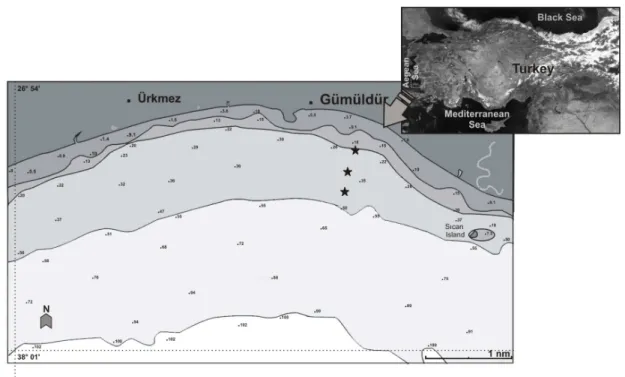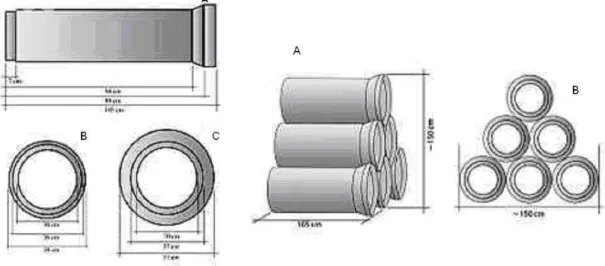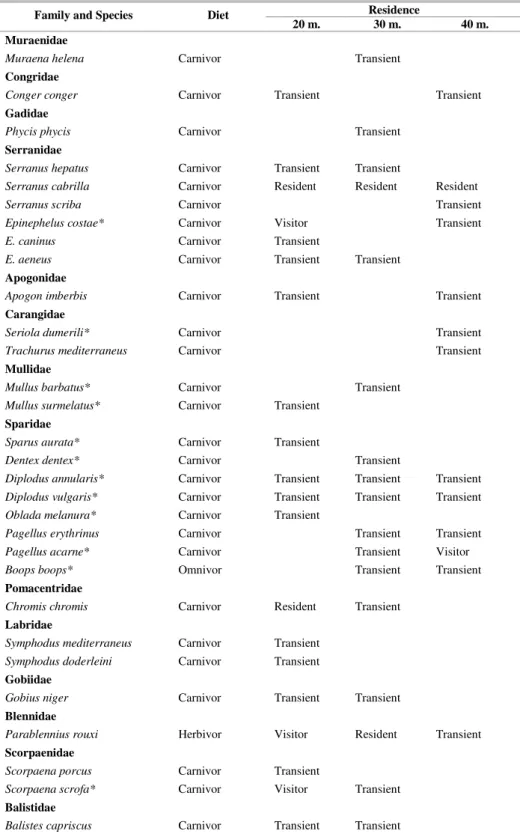COMPARISON OF FISH COMMUNITY STRUCTURE ON ARTIFICIAL REEFS DEPLOYED AT DIFFERENT DEPTHS ON TURKISH AEGEAN SEA COAST*
Benal Gü11**, Altan Lök1, Aytaç Özgül1, Ali Ula 2, F. Ozan Düzbastilar2 and Cengiz Metrin2
1Ege University, Faculty of Fisheries
(Bornova, 35100, Đzmir, Turkey)
2Ege University Underwater Research and Application Center
(Đskele Urla 35440 Đzmir Turkey)
**Corresponding author: benalgul@yahoo.com
A
B S T R A C TDeployment depth of artificial reefs is one of the most important issue in planning stage and future success. Most of the studies aimed at determination of fish community around artificial reefs were conducted mainly 10-25m depths in Mediterranean and Aegean Sea. The goals of this study are determine and compare of fish community structure around artificial reefs which deployed 20, 30 and 40 m depths. Underwater visual census technique was used to determine fish species, number of individual and size estimation. There was no statistical difference (p>0.05) in mean fish biomass and number of individual between the depths. But mean species number was significantly greater on 20 m in comparison to 30 m and 40 m depths (p<0.05). Furthermore, calculated values of Jaccard and Bray-Curtis indexes showed low similarity (min. 3% - max. %37) between depths.
R
E S U M OA profundidade da implantação de recifes artificiais é uma das questões mais importantes no planejamento de etapas e do futuro êxito. A maior parte dos estudos visando determinar a comunidade de peixes em volta de recifes artificiais foi realizada, principalmente , a profundidades de 10-25m no Mediterrâneo e Mar Egeu. Os objetivos deste estudo são determinar e comparar a estrutura da comunidade de peixes em volta de recifes artificiais que foram implantados a profundidades de 20, 30 e 40 m. A técnica de censo visual foi usada para determinar as espécies e obter uma estimativa do número e tamanho dos peixes. Não houve nenhuma diferença estatística (p> 0.05) entre as profundidades, na média da biomassa de peixes e no número de indivíduos. Entretanto, a média do número de espécies foi significativamente maior nos 20 m em comparação com as profundidades de 30 m e de 40 m (p <0.05). Além disso, os valores calculados dos índices de Zurro-Curtis e Jaccard revelaram pequena semelhança (minuto 3% - máximo %37) entre as profundidades.
Descriptors: Artificial reef, Fish community, Underwater visual census, Aegean Sea. Descritores: Recife artificial, Comunidade de peixes, Censo visual, Mar Egeu.
INTRODUCTION
Artificial reef research in Turkey was begun in 1991 and mainly took place on the Aegean Sea coast (LÖK et al., 2002). Coastal municipalities and fishery cooperatives showed intense interest in artificial reef projects as from 1995. Twenty-two artificial reef projects were planned by coastal municipalities between 1995 and 2009, but artificial reef studies were undertaken only very slowly thereafter.
__________
(*) Paper presented at the 9th CARAH – International Conference on
Artificial Reefs and Related Aquatic Habitats on 8-13 November,
Most of the studies aiming at the determination of fish communities in the proximity of artificial reefs have mainly been conducted, in the Mediterranean and Aegean Seas, at depths of 10-25m. For this reason, there are no descriptive or comparative studies on fish community structures around artificial reefs deployed at different depths in the eastern Mediterranean.
Artisanal fishery communities are demanding that artificial reefs should be deployed (or, are calling for the deployment of artificial reefs) in deeper waters. The fishermen involved are supposing that they will thus obtain new fishing grounds where they will be able to catch high value fish such as groupers, red sea bream etc. The Ministry of Agriculture and Rural Affairs has asked the researchers to investigate (or, has asked researchers about) fish community structure on deeper artificial reefs.
The aim of this present study is to determine and compare the fish community structures around artificial reefs deployed at three different depths (20 m, 30 m and 40 m) on the Turkish Aegean Sea coast.
M
ETHODS Study AreaGümüldür is a coastal village located on the Gulf of Ku adası, 60 km south of Đzmir (Fig. 1). The sea bottom between 0 and 5m is sandy; that between 5 and 15m is covered by Posidonia oceanica meadows and is followed by a muddy zone extending to deeper areas. The Gulf of Ku adası is oligotrophic and its chl-a vchl-alues vchl-ary between 0.3 chl-and 1.7µg/l. During the study period, the lowest sea surface temperature (140C) was recorded in February and the highest (250C) in August.
Artificial reef Design and Deployment Plan Concrete culverts of 30-cm diameter and 105cm in length were used as artificial reef units (Fig.2). To construct a reef set, six of these units were stacked (3-2-1) into a pyramid. Nine pyramid-shaped reef sets were constructed and three of them were deployed at each depth (20, 30 and 40 m) in April 2006 (Fig. 2). The distance between the sets was of approximately 25m.
Fig. 1. Study area and location of artificial reefs.
Fig. 2. Artificial reef design and illustration of reef deployment.
Sampling
Fish communities were sampled for species composition, abundance and fish size between July 2006 and June 2008. The same divers undertook censuses of all fish at the same time of day, identified the species and estimated individual sizes using visual census methods (HARMELIN-VIVIEN et al., 1985; BORTONE; KIMMEL, 1991; BOHNSACK et al., 1994). Large fish were first surveyed and then the reefs were closely examined for small and cryptic species. The three artificial reef sets at each depth were visited during all the observations.
Data Analysis
Fish species richness, abundance, biomass and biodiversity (H’) were examined using a mixed model analysis of variance (ANOVA) using SPSS 15.0 software. A probability value of less than 0.05 by ANOVA was accepted as a significant difference. Bray-Curtis dissimilarity and Jaccard similarity indices were used to examine potential differences in fish community structure between depths.
R
ESULTSA total of 30 species belonging to 14 families were recorded on all the reef sets. The most abundant families were Sparidae and Serranidae (Table 1). The dominant Sparid species was Pagellus acarne, which represented 48% of the total bream abundance. Eighteen species were classified as of commercial value and carnivores were clearly
There were significantly higher family number and species richness on artificial reefs at 20 m. Eleven families and 20 species were recorded during the study period. C.chromis was the dominant species and represented 50% of total fish abundance. Seventeen species belonging to 10 families were observed at 30 m. and 6 families were represented by 13 species at 40 m. Pagellus acarne was the dominant species at 30 m and 40 m. and represented ~60 % of total abundance on both artificial reef sets.
Although the artificial reefs at 20 m depth have the highest species number, mean abundance and mean biomass were greater on the artificial reefs at 40 m than on those at the other depths. Shannon-Wiener values varied between 0.75 and 1.7 on the artificial reef at 20 m and biodiversity increased continuously after deployment. While 30 m biodiversity values varied between 0.19 and 1.17, the lowest values were found on the artificial reefs at 40 m (between 0.04 - 0.69).
Species richness values were statistically significantly different between depths (p<0.05). Statistical analysis shows that no statistically significant differences occurred when comparing fish abundance and biomass at the various artificial reef depths (p>0.05).
Table 1. Species list of artificial reef site.
Residence
Family and Species Diet
20 m. 30 m. 40 m.
Muraenidae
Muraena helena Carnivor Transient
Congridae
Conger conger Carnivor Transient Transient
Gadidae
Phycis phycis Carnivor Transient
Serranidae
Serranus hepatus Carnivor Transient Transient
Serranus cabrilla Carnivor Resident Resident Resident
Serranus scriba Carnivor Transient
Epinephelus costae* Carnivor Visitor Transient
E. caninus Carnivor Transient
E. aeneus Carnivor Transient Transient
Apogonidae
Apogon imberbis Carnivor Transient Transient
Carangidae
Seriola dumerili* Carnivor Transient
Trachurus mediterraneus Carnivor Transient
Mullidae
Mullus barbatus* Carnivor Transient
Mullus surmelatus* Carnivor Transient
Sparidae
Sparus aurata* Carnivor Transient
Dentex dentex* Carnivor Transient
Diplodus annularis* Carnivor Transient Transient Transient
Diplodus vulgaris* Carnivor Transient Transient Transient
Oblada melanura* Carnivor Transient
Pagellus erythrinus Carnivor Transient Transient
Pagellus acarne* Carnivor Transient Visitor
Boops boops* Omnivor Transient Transient
Pomacentridae
Chromis chromis Carnivor Resident Transient
Labridae
Symphodus mediterraneus Carnivor Transient
Symphodus doderleini Carnivor Transient
Gobiidae
Gobius niger Carnivor Transient Transient
Blennidae
Parablennius rouxi Herbivor Visitor Resident Transient
Scorpaenidae
Scorpaena porcus Carnivor Transient
Scorpaena scrofa* Carnivor Visitor Transient
Balistidae
Balistes capriscus Carnivor Transient Transient
A B
D
ISCUSSIONResults show that there is a major difference in fish composition as between depths, especially between that at 20 m and 40 m. Artificial reefs at 20 m depth had high species number, though each species was represented by few individuals. Artificial reefs at 40 m, although having the lowest species number, present schools of some species which contribute to higher abundance and biomass. The higher commercial value of these schools permits us to affirm that deeper artificial reefs can be use as tools to support recreational small-scale fisheries. But long-term observations and fisheries studies would be necessary to permit one to make this kind of suggestion.
There is no possibility of comparing this study with others on the effect of depth on the fish composition of artificial reefs. Relini et al. (2007) reported that six barges, two each at 20, 30 and 40 m depth, had been immersed in the coastal waters off Camogli in October 1979, but that they had not been studied since.
Gül et al. (2006) conducted a study at the different artificial reef sites in the same region and found that 6 years after the reefs’ deployment, the fish assemblages on them, in a muddy area, presented 12 families and 32 species. A comparison of the results showed that, especially on the artificial reefs at 20 m, succession proceeds rapidly.
The absence of many species and the presence of some schools on artificial reefs at 40 m depth may be due to the surrounding substrate. In Gümüldür, the seagrass meadows begin near the seashore and descend to ~15m depth. Some species (e.g. labrids) were observed traveling between muddy sea-bed and seagrass meadows on the artificial reefs at 20 m depth. However, at the artificial reefs at 40 m, ~1 mile from the shore, there is no connection with the seagrass meadows. On the 30 m and 40 m deep reefs the dominance of Pagellus acarne, which prefers worms, mollusks and crustaceans, may be due to the surrounding muddy area. The absence of some species may thus be due to habitat relations (or, their relationships with specific habitats.). The consideration of this kind of result will be of importance to the success of artificial reef projects.
Progress in fish compositions could be clearly observed at all depths over the 2-year period. Low species numbers, abundance, biomass and biodiversity values increased over time. This process took place more quickly at 20 m depth, especially as regards species number. The effect of sun light may be an important factor contributing to this result. The reefs at 30 m always showed intermediate values between those at 20 m and 40 m depths.
A large number of carnivore species was recorded and their dominance may be the cause of their having such a marked effect on the presence/absence of larvae. Bohnsack et al. (1991) suggest that carnivore species tend to be dominant in fish assemblages.
The consideration of this kind of result will be of importance to the success of artificial reef projects, especially as regards their use as a tool for fisheries management.
ACKNOWLEDGMENTS
We wish to thank B. Rüzgar and E. Ergün for their logistical support as also the crew members of the Research Vessel (EGESÜF), O. Öner and A. Aksade. We also thank G. Metin, Đ. Aydın, N. Güne and M. Bilecenoğlu for their help during the cruise and assistance with the data analysis.
REFERENCES
BOHNSACK, J. A.; JOHNSON, D. L.; AMBROSE, R. F. Ecology of artificial reef habitats and fishes. In: SEAMAN, JR, W.; SPRAGUE, L. M. (Ed.). Artificial habitat for marine and freshwater fisheries. San Diego: Academic Press, 1991. p. 61-107.
BOHNSACK, J. A.; HARPER, D. E.; MCCLELLAN, D. B.; HULSBECK, M. Effects of reef size on colonization and assemblage structure of fishes at artificial reefs off southeastern Florida, U.S.A. Bull. mar. Sci., v. 55, n. 2-3, p. 796-822-3, 1994.
BORTONE, S. A.; KIMMEL, J. J. Environmental assessment and monitoring of artificial reefs. In: W. SEAMAN JR., W. ; SPRAGUE, L. M. (Ed.). Artificial habitats for marine and freshwater fisheries. San Diego: Academic Press, 1991. p. 177-236.
GÜL, B.; LÖK, A.; ULA , A.; DÜZBASTILAR, F. O. Effects of surrounding substrates on artificial reef fish assemblages off the Aegean Sea coast of Turkey. Bull. mar. Sci.., v. 78, n. 1, p. 221-226, 2006.
HARMELĐN-VĐVĐEN, M.; HARMELĐN, J. G.; CHAUVET, C.; DUVAL, C.; GALZĐN, R.;
LEJEUNE, P.; BARNABÉ, G.; BLANC, F.; CHEVALĐER, R.; DUCLERC, J.; LASSERRE, G.
Evaluation visuelle des peuplements et populations de poissons. Méthodes et problèmes. Rev. Ecol. (Terre Vie), v. 40, p. 467-539, 1985.
LÖK, A.; METĐN, C.; ULA , A.; DÜZBASTĐLAR, F.O.;
TOKAÇ, A. Artificial reefs in Turkey. ICES J. mar. Sci., v. 59, p. 192-195, 2002.
RELĐNĐ, G.; RELĐNĐ, M.; PALANDRĐ, G.; MERELLO, S.; BECCORNĐA, E. History, ecology and trends for artificial reefs of the Ligurian Sea, Italy. Hidrobiologia, v. 580, p. 193 - 217, 2007



